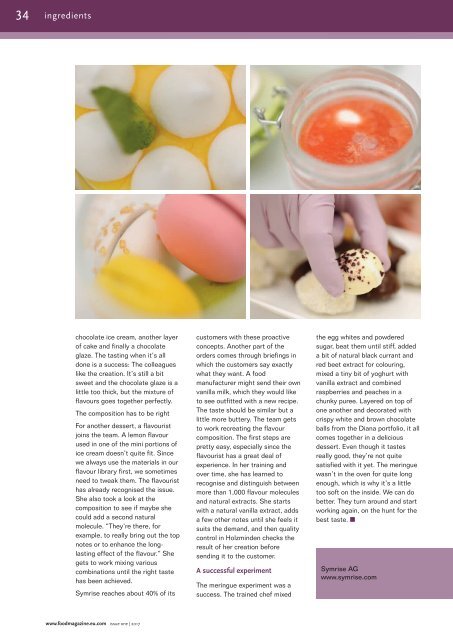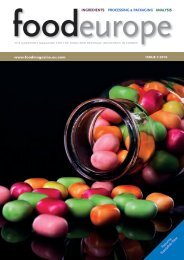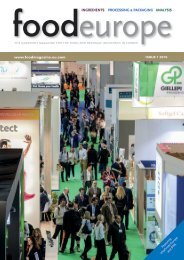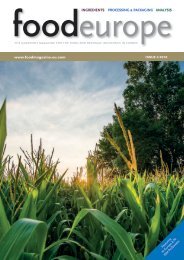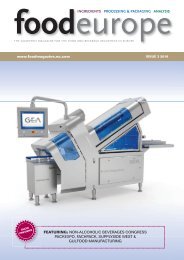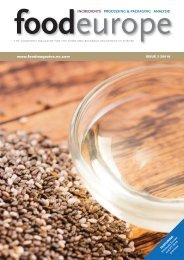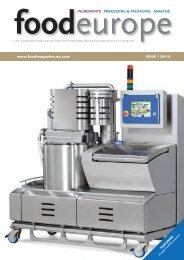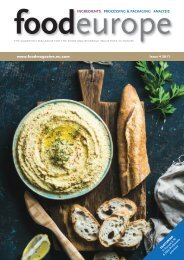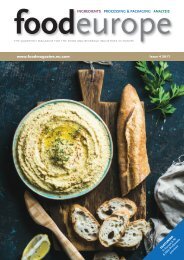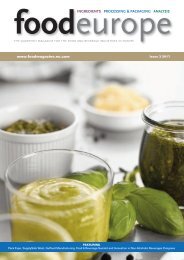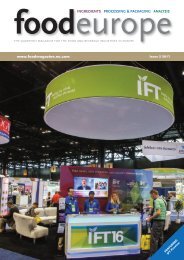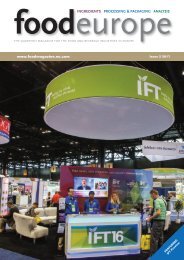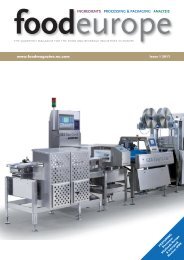issue 1 2017
Issue 1 2017 of FoodEurope Magazine
Issue 1 2017 of FoodEurope Magazine
Create successful ePaper yourself
Turn your PDF publications into a flip-book with our unique Google optimized e-Paper software.
34<br />
ingredients<br />
chocolate ice cream, another layer<br />
of cake and finally a chocolate<br />
glaze. The tasting when it’s all<br />
done is a success: The colleagues<br />
like the creation. It’s still a bit<br />
sweet and the chocolate glaze is a<br />
little too thick, but the mixture of<br />
flavours goes together perfectly.<br />
The composition has to be right<br />
For another dessert, a flavourist<br />
joins the team. A lemon flavour<br />
used in one of the mini portions of<br />
ice cream doesn’t quite fit. Since<br />
we always use the materials in our<br />
flavour library first, we sometimes<br />
need to tweak them. The flavourist<br />
has already recognised the <strong>issue</strong>.<br />
She also took a look at the<br />
composition to see if maybe she<br />
could add a second natural<br />
molecule. “They’re there, for<br />
example, to really bring out the top<br />
notes or to enhance the longlasting<br />
effect of the flavour.” She<br />
gets to work mixing various<br />
combinations until the right taste<br />
has been achieved.<br />
Symrise reaches about 40% of its<br />
customers with these proactive<br />
concepts. Another part of the<br />
orders comes through briefings in<br />
which the customers say exactly<br />
what they want. A food<br />
manufacturer might send their own<br />
vanilla milk, which they would like<br />
to see outfitted with a new recipe.<br />
The taste should be similar but a<br />
little more buttery. The team gets<br />
to work recreating the flavour<br />
composition. The first steps are<br />
pretty easy, especially since the<br />
flavourist has a great deal of<br />
experience. In her training and<br />
over time, she has learned to<br />
recognise and distinguish between<br />
more than 1,000 flavour molecules<br />
and natural extracts. She starts<br />
with a natural vanilla extract, adds<br />
a few other notes until she feels it<br />
suits the demand, and then quality<br />
control in Holzminden checks the<br />
result of her creation before<br />
sending it to the customer.<br />
A successful experiment<br />
The meringue experiment was a<br />
success. The trained chef mixed<br />
the egg whites and powdered<br />
sugar, beat them until stiff, added<br />
a bit of natural black currant and<br />
red beet extract for colouring,<br />
mixed a tiny bit of yoghurt with<br />
vanilla extract and combined<br />
raspberries and peaches in a<br />
chunky puree. Layered on top of<br />
one another and decorated with<br />
crispy white and brown chocolate<br />
balls from the Diana portfolio, it all<br />
comes together in a delicious<br />
dessert. Even though it tastes<br />
really good, they’re not quite<br />
satisfied with it yet. The meringue<br />
wasn’t in the oven for quite long<br />
enough, which is why it’s a little<br />
too soft on the inside. We can do<br />
better. They turn around and start<br />
working again, on the hunt for the<br />
best taste. n<br />
Symrise AG<br />
www.symrise.com<br />
www.foodmagazine.eu.com <strong>issue</strong> one | <strong>2017</strong>


